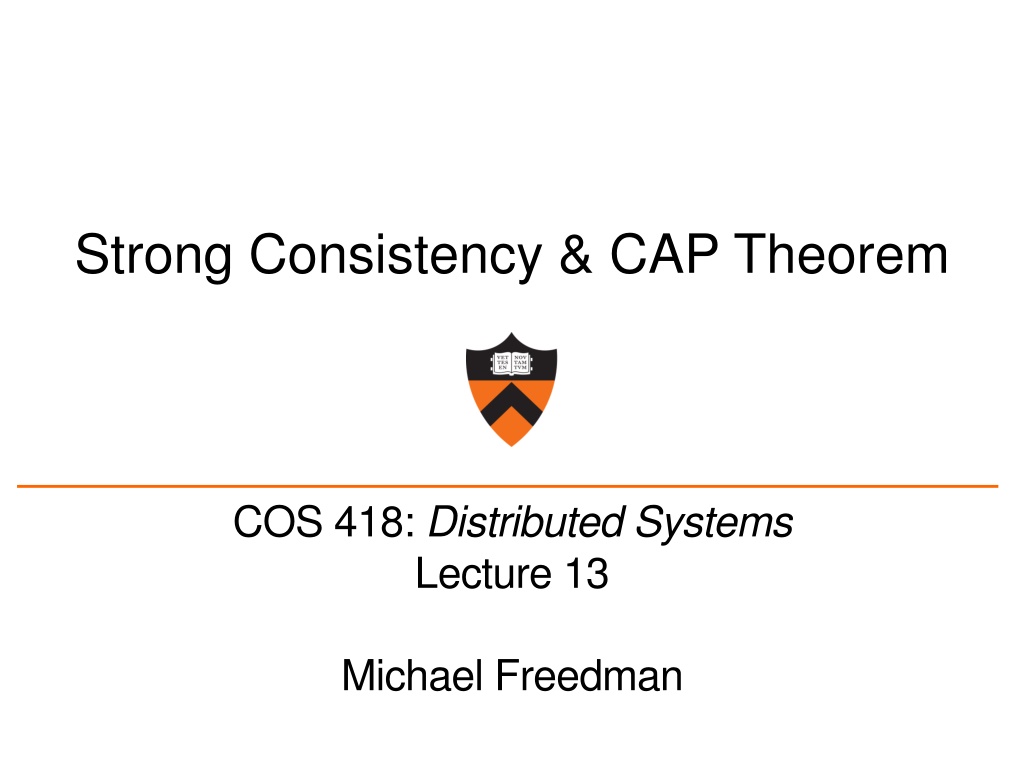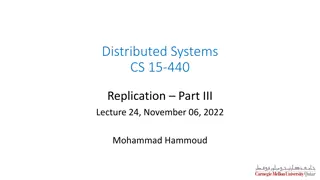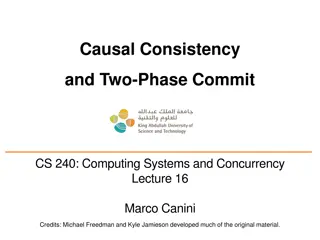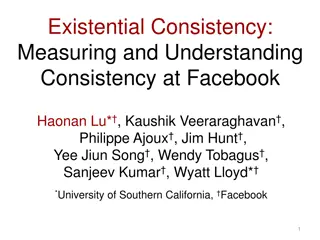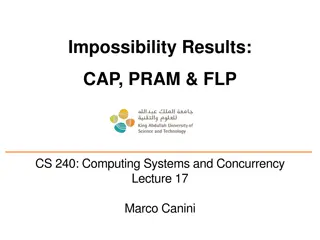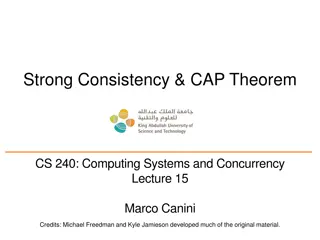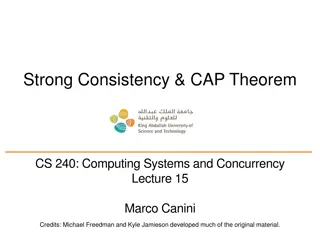Understanding Strong Consistency and CAP Theorem in Distributed Systems
Strong consistency and the CAP theorem play a crucial role in the design and implementation of distributed systems. This content explores different consistency models such as 2PC, consensus, eventual consistency, Paxos, and Raft, highlighting the importance of maintaining ordering and fault-tolerance. It delves into the behavior of systems like Paxos and Raft in ensuring strong consistency, discussing scenarios and tricks to achieve optimal consistency levels. Linearizability is emphasized as a key concept to maintain global ordering and preserve client operations in a distributed environment.
Download Presentation

Please find below an Image/Link to download the presentation.
The content on the website is provided AS IS for your information and personal use only. It may not be sold, licensed, or shared on other websites without obtaining consent from the author. Download presentation by click this link. If you encounter any issues during the download, it is possible that the publisher has removed the file from their server.
E N D
Presentation Transcript
Strong Consistency & CAP Theorem COS 418: Distributed Systems Lecture 13 Michael Freedman
Consistency models 2PC / Consensus Eventual consistency Paxos / Raft Dynamo 2
Consistency in Paxos/Raft shl Consensus Module State Machine Consensus Module State Machine Consensus Module State Machine Log Log Log add jmp mov shl add jmp mov shl add jmp mov shl Fault-tolerance / durability: Don t lose operations Consistency: Ordering between (visible) operations
Correct consistency model? B A Let s say A and B send an op. All readers see A B ? All readers see B A ? Some see A B and others B A ?
Paxos/RAFT has strong consistency Provide behavior of a single copy of object: Read should return the most recent write Subsequent reads should return same value, until next write Telephone intuition: 1. Alice updates Facebook post 2. Alice calls Bob on phone: Check my Facebook post! 3. Bob read s Alice s wall, sees her post 5
Strong Consistency? write(A,1) success 1 read(A) Phone call: Ensures happens-before relationship, even through out-of-band communication 6
Strong Consistency? write(A,1) success 1 read(A) One cool trick: Delay responding to writes/ops until properly committed 7
Strong Consistency? This is buggy! write(A,1) success 1 committed read(A) Isn t sufficient to return value of third node: It doesn t know precisely when op is globally committed Instead: Need to actually order read operation 8
Strong Consistency! write(A,1) success 1 read(A) Order all operations via (1) leader, (2) consensus 9
Strong consistency = linearizability Linearizability (Herlihy and Wang 1991) 1. All servers execute all ops in some identical sequential order 2. Global ordering preserves each client s own local ordering 3. Global ordering preserves real-time guarantee All ops receive global time-stamp using a sync d clock If tsop1(x) < tsop2(y), OP1(x) precedes OP2(y) in sequence Once write completes, all later reads (by wall-clock start time) should return value of that write or value of later write. Once read returns particular value, all later reads should return that value or value of later write.
Intuition: Real-time ordering write(A,1) success 1 committed read(A) Once write completes, all later reads (by wall-clock start time) should return value of that write or value of later write. Once read returns particular value, all later reads should return that value or value of later write. 11
Weaker: Sequential consistency Sequential = Linearizability real-time ordering 1. All servers execute all ops in some identical sequential order 2. Global ordering preserves each client s own local ordering With concurrent ops, reordering of ops (w.r.t. real-time ordering) acceptable, but all servers must see same order e.g., linearizability cares about time sequential consistency cares about program order
Sequential Consistency write(A,1) success 0 read(A) In example, system orders read(A) before write(A,1) 13
Valid Sequential Consistency? x Why? Because P3 and P4 don t agree on order of ops. Doesn t matter when events took place on diff machine, as long as proc s AGREE on order. What if P1 did both W(x)a and W(x)b? - Neither valid, as (a) doesn t preserve local ordering
Tradeoffs are fundamental? 2PC / Consensus Eventual consistency Paxos / Raft Dynamo 15
CAP Conjection for Distributed Systems From keynote lecture by Eric Brewer (2000) History: Eric started Inktomi, early Internet search site based around commodity clusters of computers Using CAP to justify BASE model: Basically Available, Soft- state services with Eventual consistency Popular interpretation: 2-out-of-3 Consistency (Linearizability) Availability Partition Tolerance: Arbitrary crash/network failures 16
CAP Theorem: Proof Not consistent Gilbert, Seth, and Nancy Lynch. "Brewer's conjecture and the feasibility of consistent, available, partition-tolerant web services." ACM SIGACT News 33.2 (2002): 51-59. 17
CAP Theorem: Proof Not available Gilbert, Seth, and Nancy Lynch. "Brewer's conjecture and the feasibility of consistent, available, partition-tolerant web services." ACM SIGACT News 33.2 (2002): 51-59. 18
CAP Theorem: Proof Not partition tolerant Gilbert, Seth, and Nancy Lynch. "Brewer's conjecture and the feasibility of consistent, available, partition-tolerant web services." ACM SIGACT News 33.2 (2002): 51-59. 19
CAP Theorem: AP or CP Not Criticism: It s not 2-out-of-3 partition tolerant Can t choose no partitions So: AP or CP 20
More tradeoffs L vs. C Low-latency: Speak to fewer than quorum of nodes? 2PC: write N, read 1 RAFT: write N/2 + 1, read N/2 + 1 General: |W| + |R| > N L and C are fundamentally at odds C = linearizability, sequential, serializability (more later) 21
PACELC If there is a partition (P): How does system tradeoff A and C? Else (no partition) How does system tradeoff L and C? Is there a useful system that switches? Dynamo: PA/EL ACID dbs: PC/EC http://dbmsmusings.blogspot.com/2010/04/problems-with-cap-and-yahoos-little.html 22
More linearizable replication algorithms 23
Chain replication Writes to head, which orders all writes When write reaches tail, implicitly committed rest of chain Reads to tail, which orders reads w.r.t. committed writes
Chain replication for read-heavy (CRAQ) Goal: If all replicas have same version, read from any one Challenge: They need to know they have correct version
Chain replication for read-heavy (CRAQ) Replicas maintain multiple versions of objects while dirty , i.e., contain uncommitted writes Commitment sent up chain after reaches tail
Chain replication for read-heavy (CRAQ) Read to dirty object must check with tail for proper version This orders read with respect to global order, regardless of replica that handles
Performance: CR vs. CRAQ 7x- 3x- 1x- R. van Renesse and F. B. Schneider. Chain replication for supporting high throughput and availability. OSDI 2004. 28 J. Terrace and M. Freedman. Object Storage on CRAQ: High-throughput chain replication for read-mostly workloads. USENIX ATC 2009.
Wednesday lecture Causal Consistency 29
